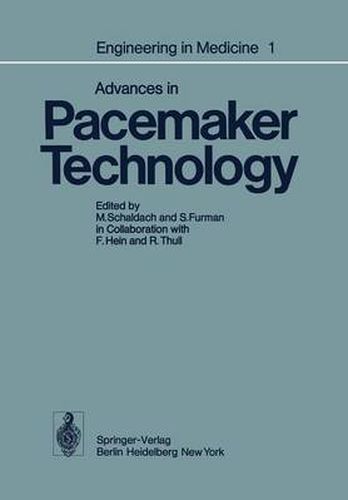Readings Newsletter
Become a Readings Member to make your shopping experience even easier.
Sign in or sign up for free!
You’re not far away from qualifying for FREE standard shipping within Australia
You’ve qualified for FREE standard shipping within Australia
The cart is loading…






This title is printed to order. This book may have been self-published. If so, we cannot guarantee the quality of the content. In the main most books will have gone through the editing process however some may not. We therefore suggest that you be aware of this before ordering this book. If in doubt check either the author or publisher’s details as we are unable to accept any returns unless they are faulty. Please contact us if you have any questions.
After more than a decade of successful application of cardiac pace makers in the therapy of cardiac rhythm disorders, technological and clinical experience has reached a level, at which a technical survey of this field should be of general interest and might promote the further improvement of pace maker therapy. The papers contained in this book were presented at the International Symposium on Advances in Pacemaker Technology, held at Erlangen on Sep tember 26 and 27,1974 under the auspices of the Societas Physica Medica Erlangensis. One of the traditional aims of the Societas has been the advance ment of diagnosis and therapy by the adaptation of medical skill to modern technology and scientific engineering conceptions. The major objective of this book is to present, in expanded form, the lectures given by internationally known basic and clinical researchers in the field of artificial pacing of the heart and to make that information available to a wider public. The experience discussed covers the principles and main methods of pacing using implantable and external, fixed rate, R-wave or P-wave triggered pacemakers with electrodes placed in the myocardium either surgically or transvenously, and powered by zinc-mercury oxide or rechargeable batteries. Particular emphasis was put on problems of pressing importance at the present time, such as the increase of pacemaker longevity with lithium iodide and nuclear-powered batteries or improved electrodes, as well as the postoperative management of a steadily increasing number of pacemaker patients.
$9.00 standard shipping within Australia
FREE standard shipping within Australia for orders over $100.00
Express & International shipping calculated at checkout
This title is printed to order. This book may have been self-published. If so, we cannot guarantee the quality of the content. In the main most books will have gone through the editing process however some may not. We therefore suggest that you be aware of this before ordering this book. If in doubt check either the author or publisher’s details as we are unable to accept any returns unless they are faulty. Please contact us if you have any questions.
After more than a decade of successful application of cardiac pace makers in the therapy of cardiac rhythm disorders, technological and clinical experience has reached a level, at which a technical survey of this field should be of general interest and might promote the further improvement of pace maker therapy. The papers contained in this book were presented at the International Symposium on Advances in Pacemaker Technology, held at Erlangen on Sep tember 26 and 27,1974 under the auspices of the Societas Physica Medica Erlangensis. One of the traditional aims of the Societas has been the advance ment of diagnosis and therapy by the adaptation of medical skill to modern technology and scientific engineering conceptions. The major objective of this book is to present, in expanded form, the lectures given by internationally known basic and clinical researchers in the field of artificial pacing of the heart and to make that information available to a wider public. The experience discussed covers the principles and main methods of pacing using implantable and external, fixed rate, R-wave or P-wave triggered pacemakers with electrodes placed in the myocardium either surgically or transvenously, and powered by zinc-mercury oxide or rechargeable batteries. Particular emphasis was put on problems of pressing importance at the present time, such as the increase of pacemaker longevity with lithium iodide and nuclear-powered batteries or improved electrodes, as well as the postoperative management of a steadily increasing number of pacemaker patients.